Fantasy Books
There, Wolves: Part II
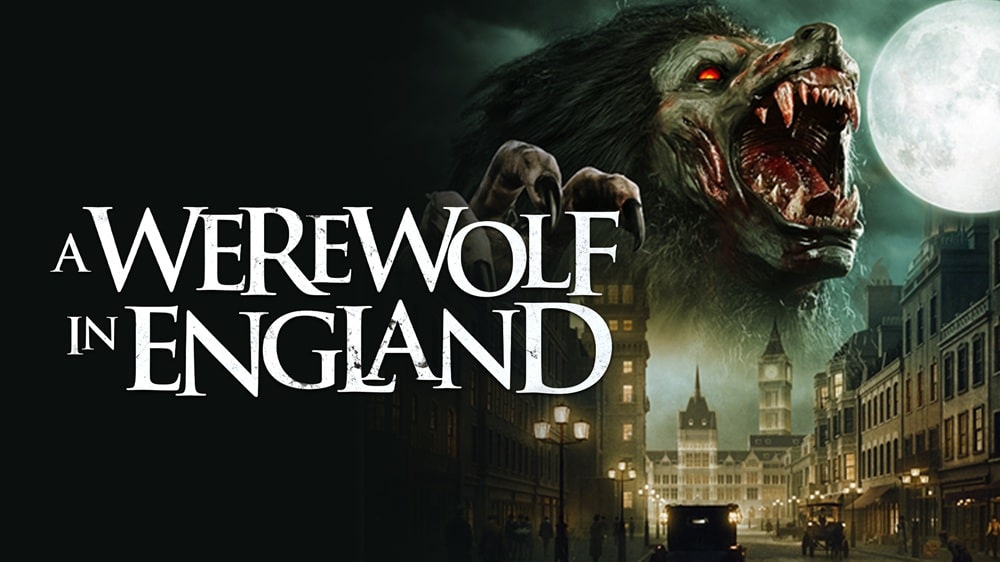 A Werewolf in England (Dark Temple Motion Pictures, 2020)
A Werewolf in England (Dark Temple Motion Pictures, 2020)
A 20 film marathon of werewolf movies I’ve never seen before.
As usual, the films must be free to stream.
I’ve got a bad feeling about this.
A Werewolf in England (2020) PrimeMan or beast? A bunch of hairy honkers.
Howlin’ good time? Hot on the heels of Werewolves Within comes another horror comedy, although this one doesn’t come close to succeeding. It starts well enough, with a title card font reminiscent of the best Bray Studios films, and some gravelly voiced dialects, but it soon regresses into a two-note gag reel of chamber pots and the contents of chamber pots.
Now, I like a good fart or poo joke as much as the next man, but the over-reliance on potty humor soon outstayed its welcome, despite a double dip into demonic diarrhea. There were moments that put me in mind of Motel Hell, but in the end the production was hampered by over saturation (seriously, filter that shit in post), poor sound design and strangely choreographed werewolves.
The beasts, more cuddly than terrifying, could have been really effective with lower lighting and more sparing framing. Oh well — it looked like everyone had fun, and it does feature the line, “I feel a tinglin’ in me nether giblets.”
6/10
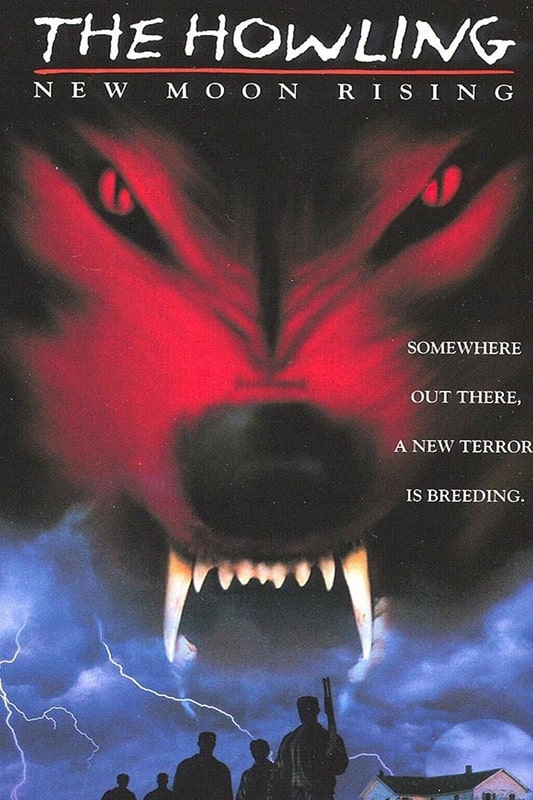
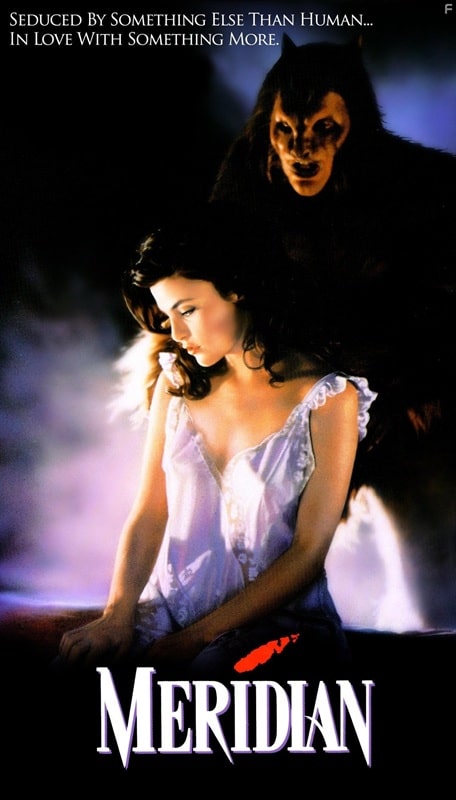
Howling VII: New Moon Rising (New Line Home Video, October 17, 1995)
and Meridian (Full Moon Features, April 13, 1990)
Man or beast? Rubbish practical/CG hybrid for all of 30 seconds at the end.
Howlin’ good time? Good people, if you’ve been reading these reviews, you’ll know I’ve watched some terrible films. You’ll also know that the worst thing a movie can do, in my opinion, is be boring. Forget the fact that this is horribly made, awfully acted, and weaves in footage from the last two films in an attempt to make sense of the story. The first hour of this mess is just unfunny bar regulars line dancing to country music while some bullshit ADR is shoveled on top of the steaming pile of plot. I honestly lost the will to live during this one. Settled for chewing my eyes out.
0/10
Meridian (1990) TubiMan or beast? Nice, practical, beast… wolf… thing.
Howlin’ good time? It’s a Full Moon feature, directed by Charles Band himself and although I think he’s a better producer, this is a nice looking film, suitably gothic for the subject matter. Meridian stars Sherilyn Fenn (and yes, I was a fully carded member of the Cult of Fenn in 1990) in a twist on the Beauty and the Beast story. In fact, it would have been a traditional, romantic ghost/beast story, if not for the unsavoury date rape that kicks off the whole affair.
The beast itself is a curious design, beautifully created by Greg (Lost Boys, Dracula) Cannom, who was definitely enjoying his ‘high brow’ phase. The prosthetics are great, and the body suit is well done; the huge hairy mass on its back is just one of a pair of extraordinary werewolf humps in the film. An interesting watch for purveyors of circus acts, nefarious twins and early 90s bosoms.
7/10
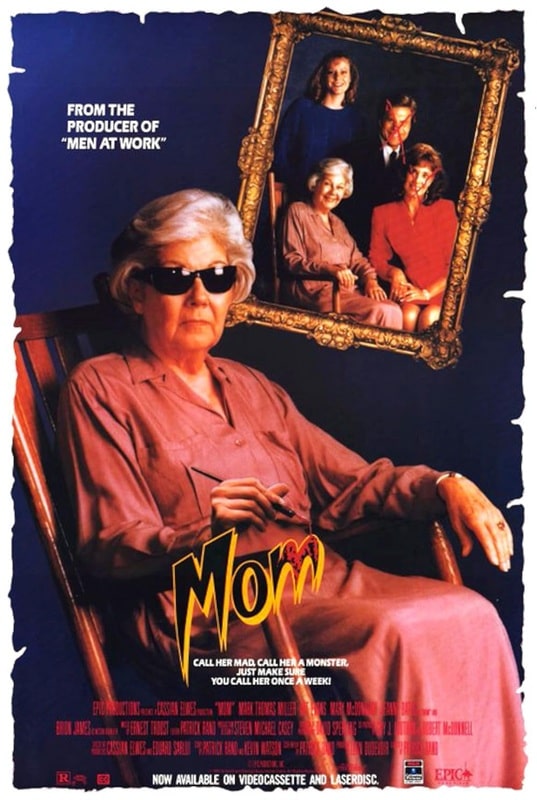
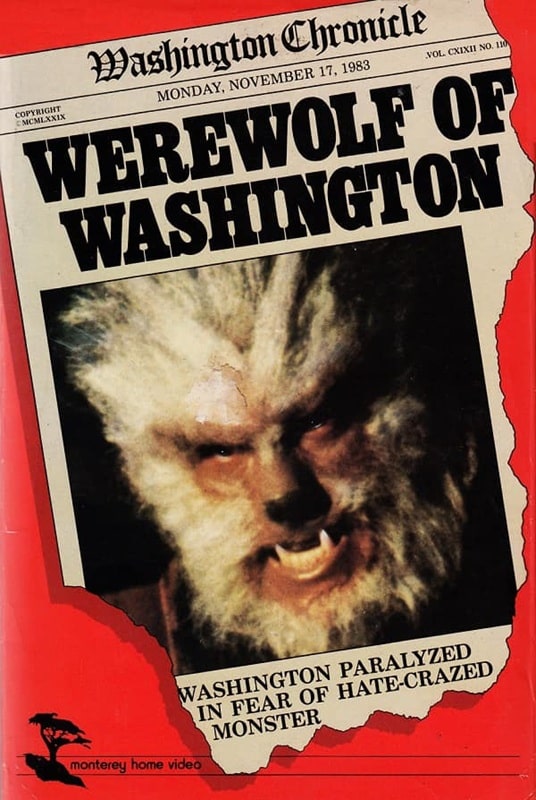
Mom (Epic Productions, June 13, 1991) and Werewolf of Washington (Diplomat Pictures, 1973)
Man or beast? Goofy were-thing.
Howlin’ good time? A 1990s horror film that is so 1990s it hurts. It starts well enough, with the wonderful Brion James as a shady, yellow-eyed drifter being aggressively creepy, and there’s a potentially excellent story to be had when our hero has to deal with his dear old mom turning into a werebeast and eating winos, but it’s not quite as exciting as I had hoped for. The creature itself is only seen in head and shoulder flashes and, although the mid-transformation make up is cool, the final creature looks goofy as all hell — we are talking Rawhead Rex goofy.
Fair to middling.
6/10
Werewolf of Washington (1973) TubiMan or beast? Hairy faced fella.
Howlin’ good time? It’s a scandal that I haven’t seen this before, but I’ve corrected that oversight. Not what I was expecting, this is a political satire wrapped up in a traditional lycanthrope yarn and it’s played for laughs. Skewering Nixon and Watergate, in this flick Dean Stockwell superbly grimaces and gurns as he changes each full moon and makes a meal of the president’s rivals. It’s basically All the President’s Wolfmen. Some genuinely funny moments (a witty script) and remarkable lapses into cinema verité elevate this hokey, bloodless romp into a film that I suspect I shouldn’t have enjoyed as much as I did.
7/10
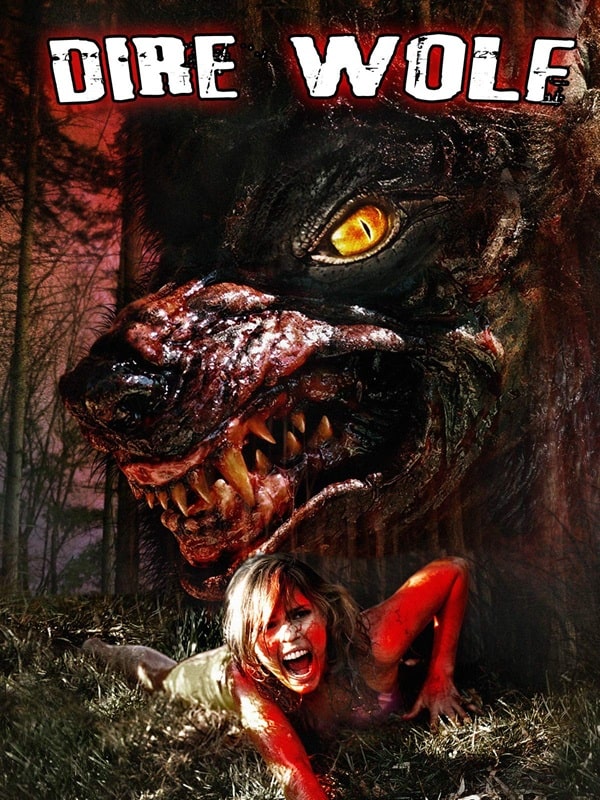 Dire Wolf (Baby Steps Entertainment, 2009)
Dire Wolf (2009) Tubi
Dire Wolf (Baby Steps Entertainment, 2009)
Dire Wolf (2009) Tubi
Man or beast? Wolf/human hybrid.
Howlin’ good time? Bit of a cheat for no. 13, as it’s not strictly a werewolf, but a lab experiment gone wrong. Nothing remarkable about it; it’s typical SyFy fare, a couple of has-beens surrounded by lacklustre actors in a daft plot, with a surprising amount of practical gore. It’s instantly forgettable. However, it did prompt an extraordinary dive into the career of Fred Olen Ray, whom I only really knew for Alienator and Hollywood Chainsaw Hookers. I’m linking the Wikipedia page for his filmography here, as it’s quite the rabbit hole.
Anyhoo – 5/10
Previous Murkey Movie surveys from Neil Baker include:
There, Wolves: Part I
What a Croc
Prehistrionics
Jumping the Shark
Alien Overlords
Biggus Footus
I Like Big Bugs and I Cannot Lie
The Weird, Weird West
Warrior Women Watch-a-thon
Neil Baker’s last article for us was There, Wolves: Part I. Neil spends his days watching dodgy movies, most of them terrible, in the hope that you might be inspired to watch them too. He is often asked why he doesn’t watch ‘proper’ films, and he honestly doesn’t have a good answer. He is an author, illustrator, outdoor educator and owner of April Moon Books (AprilMoonBooks.com).
The Quiet Mindfulness of Page Turning and 8 Transformative Novels
In this LitStack Rec, let’s explore the myriad benefits of page turning and its potential…
The post The Quiet Mindfulness of Page Turning and 8 Transformative Novels appeared first on LitStack.
SHROUD by Adrian Tchaikovsky
Cover Reveal: Space Ships! Ray Guns! Martian Octopods!: Interviews with Science Fiction Legends, edited by Richard Wolinsky
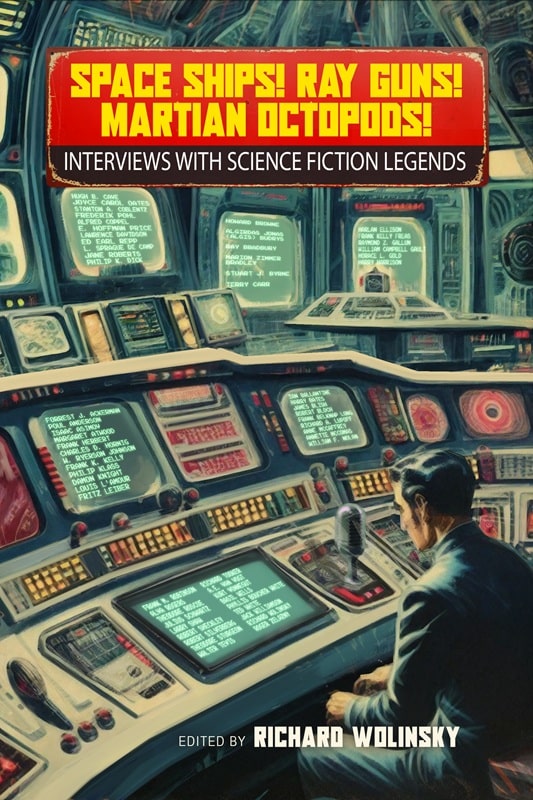 Space Ships! Ray Guns! Martian Octopods!: Interviews with Science Fiction Legends (Tachyon Publications, September 2, 2025). Cover by Yoshi Vu
Space Ships! Ray Guns! Martian Octopods!: Interviews with Science Fiction Legends (Tachyon Publications, September 2, 2025). Cover by Yoshi Vu
At Black Gate, we’re all about science fiction legends. Specifically, science fiction legends who appeared in paperback in spinner racks in the 70s and 80s. Or pulp magazines. Or wrote adventures at the dawn of the role playing industry. You know what, forget all that. We’re not picky.
What makes a true science fiction legend? This is the sort of thing that’s hotly debated on social media, and at science fiction conventions, and in lengthy blog posts titled “Towards a New Science Fiction Canon, Because Yours is Old and Stupid.” But recently, public opinion has shifted. To be a science fiction legend, the most important criteria is that your name looks good in green font on a 50s CRT monitor, preferably in a cool underground bunker. Exactly like the cover of Space Ships! Ray Guns! Martian Octopods!: Interviews with Science Fiction Legends, the upcoming book from Richard Wolinsky and Tachyon Publications.
I’ve spent long hours staring at this cover (by the marvelously talented Yoshi Vu), and the more I do, the more I’m convinced I’m right. Just look at those names. Look at how cool they are! Roger Zelazny, Theodore Sturgeon, Robert Sheckley, Jack Williamson, Fritz Leiber, Damon Knight, Poul Anderson, Isaac Asimov, Anne McCaffrey, William F. Nolan, Terry Carr, Frederik Pohl. Right now you’re shaking your head, but you know I’m right.
Those glowing green names don’t just constitute a comprehensive list of true science legends. Coincidentally, they also happen to be included in this fabulous book of interviews. Don’t take my word for it; here’s the press release to show how right I am.
In this collection of candid interviews, more than fifty legendary authors swap fascinating — and sometimes controversial — anecdotes about the Golden Age of science Fiction (1920–1960). With such guests as Ray Bradbury, Robert Bloch, Harlan Ellison, Philip K. Dick, Isaac Asimov, Margaret Atwood, Fritz Leiber, Frank Herbert, and many more, here are the wild personalities, sparks of contention, and vivid imaginations that made science fiction thrive.
Today, depictions of aliens, rocket ships, and awe-inspiring, futuristic space operas are everywhere. Why is there so much science fiction, and where did it come from? Radio producer and author Richard Wolinsky (Probabilites) has found answers in the Golden Age of science fiction.
Wolinsky has interviewed a veritable who’s who of famous (and infamous) science fiction publishers, pulp magazines, editors, cover artists, and fans. The interviews themselves, which aired on the public radio show, Probabilities, span more than twenty years, from just before the release of Star Wars through the dawn of Y2K. The result, Space Ships! Ray Guns! Martian Octopods!, is ultimately a love letter to fandom.
See? I told you.
I’m not familiar with Richard Wolinsky, but it’s clear that I should be. He cohosted Probabilities, a half-hour public radio program devoted to science fiction, mystery, and mainstream fiction, which aired in San Francisco for nearly twenty years, from 1977 – 1995. After he took the program solo in 2002 he renamed it Bookwaves, and that incarnation is still running.
Space Ships! Ray Guns! Martian Octopods!: Interviews with Science Fiction Legends belongs on every serious science fiction bookshelf. It definitely belongs on mine, anyway.
It will be released from Tachyon Publications on September 2, 2025. It is 256 pages, priced at $18.95 in paperback and $11.00 in digital formats. Get more details and order copies directly from the publisher here.
The Enchanted Greenhouse - Early Book Review
 The Enchanted Greenhouseby Sarah Beth Durst
The Enchanted Greenhouseby Sarah Beth DurstWhat is it about:New York Times bestselling author Sarah Beth Durst invites you to her new standalone novel nestled on a far-away island brimming with singing flowers, honey cakes, and honeyed love. The hardcover edition features beautiful sprayed edges.
Terlu Perna broke the law because she was lonely. She cast a spell and created a magically sentient spider plant. As punishment, she was turned into a wooden statue and tucked away into an alcove in the North Reading Room of the Great Library of Alyssium.
This should have been the end of her story . . . Yet one day, Terlu wakes in the cold of winter on a nearly-deserted island full of hundreds of magical greenhouses. She’s starving and freezing, and the only other human on the island is a grumpy gardener. To her surprise, he offers Terlu a place to sleep, clean clothes, and freshly baked honey cakes—at least until she’s ready to sail home.
But Terlu can’t return home and doesn’t want to—the greenhouses are a dream come true, each more wondrous than the next. When she learns that the magic that sustains them is failing—causing the death of everything within them—Terlu knows she must help. Even if that means breaking the law again.
This time, though, she isn’t alone. Assisted by the gardener and a sentient rose, Terlu must unravel the secrets of a long-dead sorcerer if she wants to save the island—and have a fresh chance at happiness and love.
Funny, kind, and forgiving, The Enchanted Greenhouse is a story about giving second chances—to others and to yourself.
What did I think of it:*I was lucky enough to get a digital Advance Reader Copy of this book*
This is a standalone set in the same world as The Spellshop, but anyone who read and loved The Spellshop will recognize who Terlu is, and so needs to read this! New to this world? You can totally read and love this book without reading the Spellshop first, but believe me: you need both these books, they're both awesome!
I liked Terlu, and had a lot of sympathy for her, but then the grumpy gardener Yarrow was introduced, and just Wow! He and I have a lot in common I have to confess. From that point on I so rooted for the both of them,(maybe a little bit more for Yarrow) that they would succeed in saving the greenhouses.
I feared one of my least favorite tropes would happen in this book, and it did, but Durst managed to write it in a way that didn't make me want to puke like I usually do with this particular trope (which I will name the 'Shiny Happy People' trope to not spoil too much).
So with a certain trope handled in the best was possible this was just as beautiful and emotional a read as The Spellshop. I loved reading about the wonders in the greenhouses, and learn more about the world Durst created. There's tons of beauty and whimsy, next to a really emotional story that also has lots to smile about.
You bet I will impatiently wait for the release and get my trotters on the hardcover to place it next to The Spellshop. And if there's to be more books: I'm going to hope it will be about certain characters who have a small role in this book.
Why should you read it:It's a great, cozy Fantasy with a wonderfully grumpy gardener.
Expected publication: July 15, 2025 by Bramble
Goth Chick News: Time Stands Still in Pause: John Carpenter’s Latest Sci-Fi Horror Comic
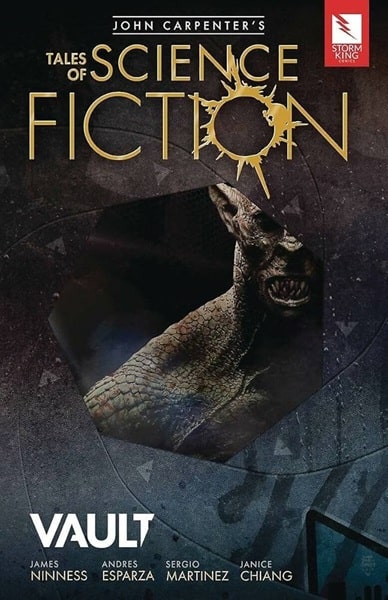
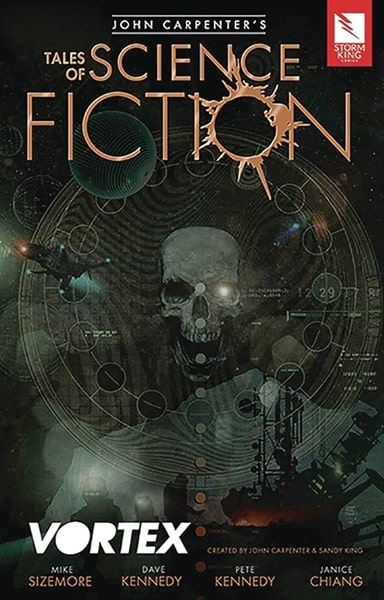
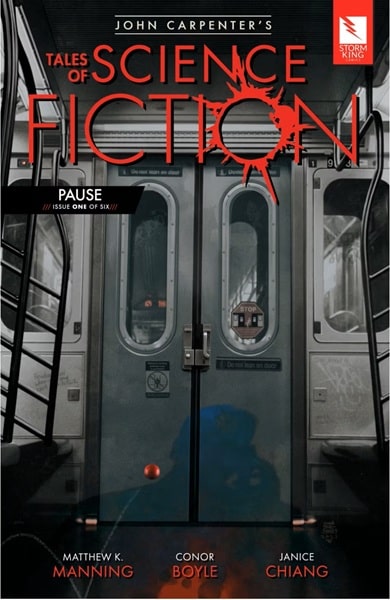
John Carpenter’s Tales of Science Fiction: Vault (June 2018), Vortex
(October 2018), and issue #1 of Pause (February 26, 2025
Storm King Comics was founded in 2012 by legendary filmmaker John Carpenter and his wife of thirty-five years, producer Sandy King. Together, they are known for delivering stories of horror, science fiction, and the supernatural, with series like John Carpenter’s Tales of Science Fiction and John Carpenter’s Tales for a HalloweeNight. Combining Carpenter’s cinematic style with the visual storytelling of comics, Storm King Comics offers fans immersive experiences that have cemented its reputation in the comic book industry.
I was first introduced to Storm King Comics by the grand dame herself, Sandy King, when I met her in 2016 at C2E2. Since then, I have collected all the issues from Tales for a HalloweeNight as well as Asylum which was my first exposure to the great stories that come out of Storm King. And though I am not a sci-fi girl strictly speaking, I love a good crossover, which this week’s launch seems to be.
For a bit of background, John Carpenter’s Tales of Science Fiction launched in 2018 with its inaugural story Vault, telling the tale of a moon-bound crew who discover an alien vessel with English markings. Since that time there have been eleven total installments and this week the series returns with installment twelve, entitled Pause.
Here’s what you have to look forward to…
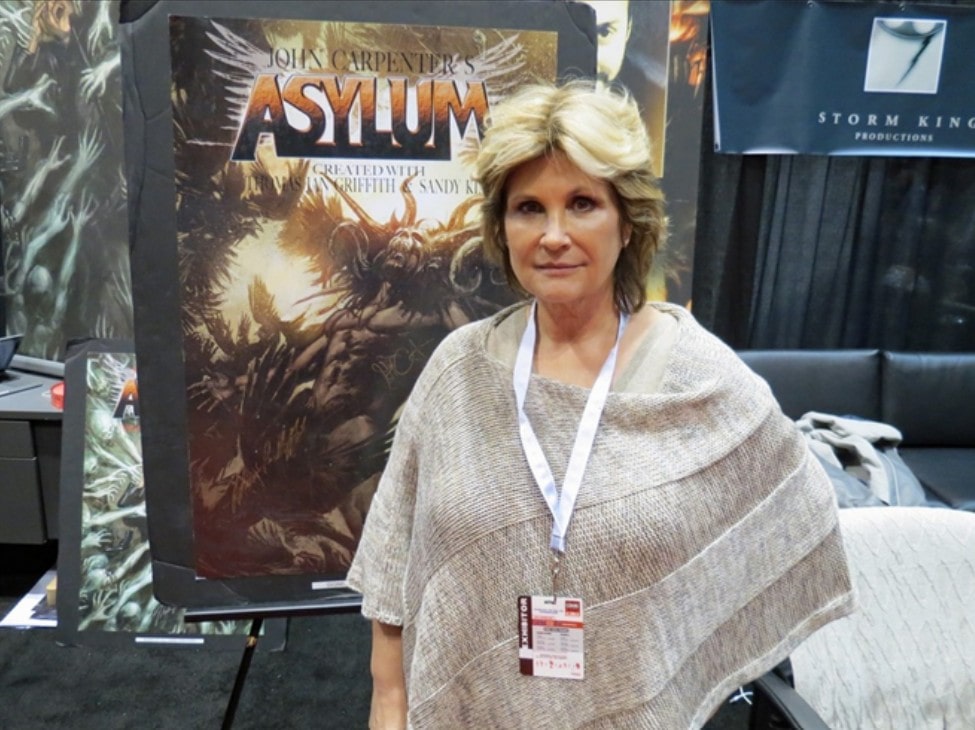 When I met Sandy in 2016
When I met Sandy in 2016
Picture this: you’re the only one not frozen in a world where time has stopped. You could lounge in a luxury Manhattan penthouse while its owner stands motionless nearby. You could feast on gourmet meals, perfectly hot and untouched, at high-end restaurants.
But what if you could bring others back to life with just a touch? Would you break the silence for companionship — or keep this frozen paradise all to yourself? The possibilities seem endless, but in a world like this, making the wrong move could unpause more than you bargained for…
Check out the trailer set to “Beyond the Gallows” from Carpenter’s latest album, Lost Themes IV: Noir.
Pause is written by Matthew K. Manning (Batman/Teenage Mutant Ninja Turtles Adventures), illustrated by Conor Boyle (Judge Dredd), and lettered by Janice Chiang.
Issue #1 of the six-issue limited series is available today, with new issues arriving monthly through August.
Review of Mother of Rome by Lauren J. A. Bear
As a Bookshop affiliate, I earn from qualifying purchases. Book Description: A powerful and fierce reimagining of the earliest Roman legend: the twins, Romulus and Remus, mythical founders of history’s greatest empire, and the woman whose sacrifice made it all possible. The names Romulus and Remus may be immortalized in map and stone and chronicle, but their mother exists only as a preface to her sons’ journey, the princess turned oath-breaking priestess, condemned to death alongside her children. But she […]
The post Review of Mother of Rome by Lauren J. A. Bear first appeared on Fantasy Cafe.Spotlight on “Twist” by Colum McCann
Twist by Colum McCann is a propulsive novel of rupture and repair in the digital…
The post Spotlight on “Twist” by Colum McCann appeared first on LitStack.
On McPig's Wishlist - The Serpent Called Mercy
 The Serpent Called Mercyby Roanne Lau
The Serpent Called Mercyby Roanne LauThe Witcher meets Squid Game in this Malaysian Chinese-inspired epic fantasy novel where a debt-ridden slumdog joins an illegal monster-fighting arena for some fast coin, but quickly learns the most dangerous beasts are outside the ring, by debut author Roanne Lau
Lythlet and her only friend Desil are shackled to a life of debt and poverty that she fears they will never escape. Desperate for money, they sign up as arena combatants who fight sun-cursed beasts in the seedy underworld of the city.
Match-master Dothilos is initially enamored of Desil’s brawling reputation, but after seeing Lythlet lead the pair to triumph with her quick cunning, he takes her under his wing, scorning Desil. Ambition takes root in Lythlet’s heart as a life of fame and wealth unfolds in her imagination.
But Lythlet isn’t the only one out for coin and glory, and she soon finds herself playing an entirely different game—a game of politics and deception. As the cost of her ambition grows, she will have to decide if sacrificing her honor, and only friendship, is worth the chance to shape her own fortune.
A whirlwind of blood-pounding battles as characters grapple with their choices in the face of wealth and financial security, The Serpent Called Mercy's heart is the underlying, steadfast friendship between its protagonists.
Expected publication: March 25, 2025
Book Review: The Ragpicker King by Cassandra Clare
I received a review copy from the publisher. This does not affect the contents of my review and all opinions are my own.
 The Ragpicker King by Cassandra Clare
The Ragpicker King by Cassandra Clare
Mogsy’s Rating: 3.5 of 5 stars
Genre: Fantasy
Series: Book 2 of The Chronicles of Castellane
Publisher: Del Rey (March 4, 2025)
Length: 576 pages
Author Information: Website
The Ragpicker King is the second book in The Chronicles of Castellane series by Cassandra Clare, returning to the intricate world established in Sword Catcher. The usual caveats apply—if you have not caught up yet, this review may contain spoilers or book one!
The story opens in the aftermath of the devastating palace massacre that shook the city of Castellane. Those involved are desperate for answers—how could this have happened, and why? Kel Saren, who has filled the role of loyal Sword Catcher since he was a young boy, serves not only as Prince Conor Aurelian’s body double and protector but now must also play an investigator, tasked with uncovering the perpetrators behind the attack. To do so, he must venture beyond the glittering court and into the city’s dark underbelly, where the powerful fixer and information broker known as the Ragpicker King reigns. As Kel’s investigation pulls him deeper into danger, he begins to realize that his ability to shield the prince has limits, especially as the crown’s enemies grow bolder. While cleaning up Conor’s messes has always been part of Kel’s duty, which he performs gladly since the two men are as close as brothers, this time the consequences may be far graver than either of them anticipate.
Meanwhile, Prince Conor himself struggles to cope with the trauma of the massacre and witnessing the death of the innocent girl to whom he had been betrothed. As rival factions in his court continue to scheme for power and influence, he has no choice but to brace for yet another arranged marriage designed to secure his kingdom’s stability—even as his heart already belongs to someone else. And across the city, Lin Caster, an Ashkar healer and granddaughter to the king’s most trusted advisor, finds herself caught in a terrible predicament of her own making. In a desperate attempt to save her sick friend, she had openly proclaimed herself the reborn Ashkar goddess. Now, a visitor has arrived in town to test her claim, ready to subject her a series of trials where failure could mean disastrous consequences.
The Ragpicker King does everything a sequel is supposed to do. Clare expands on the world-building that made Sword Catcher so compelling, further exploring Castellane’s political landscape and the murky conspiracies simmering beneath its surface. In addition, she continues to bolster the storytelling by adding more to both court intrigue and personal dramas. Profound changes take place as characters mature in the face of new struggles, especially in Conor’s case. Once carefree and impulsive, the prince is finally beginning to take Kel’s advice to heart—learning that it’s time to grow up and be a true leader. However, taking responsibility also comes with a downside as his new aspirations come in conflict with the status quo at court, causing heightened political tensions. Subsequently, Kel’s natural instinct to shield his friend from further confrontation actually ends up doing more harm than good. He remains my favorite protagonist, dealing with his identity and place in the world as “Sword Catcher.” Lin, on the other hand, sees her star fade a little in this second novel as her storyline takes her farther away from the main plot at cause, causing her chapters to feel somewhat apart and disconnected.
Despite all these developments, pacing is also a mixed bag. The novel feels much longer than it is, due to the burden of lengthy explanations and setup. The narrative frequently goes on tangents, trying to shoehorn in and lingering on the characters’ various romantic entanglements. Don’t get me wrong, I don’t mind a little romance, but definitely not at the expense of the more significant stakes unfolding in the world at large. A touch of spice can add interest and depth, but with so much else at play, who gets paired up with whom is the least of my concern and feels like a distraction. In particular, the middle section dragged on with its meandering, soap opera-style drama, while the main story arc was crying out for more attention and momentum.
Happily, things pick up in the later parts of the book, where we see much stronger cohesion. As the plot reaches the climax, it unleashes a bombshell and an emotional payoff that’s worthy of the buildup. While it leaves some threads unresolved, including major changes for all our protagonists, the ending leaves plenty of motivation to pick up the next installment.
Ultimately, The Ragpicker King is a sequel that—while ambitious and expansive—is far from perfect. It does plenty of things well, including building upon the scope of its world, but admittedly it also stumbles in other areas, like pacing and character balance. On the whole, it also has the unmistakable feel of a bridge book. That said, I am interested in seeing how the next installment will handle the questions and conflicts that have been left enticingly open. The book’s ending sets the stage for what promises to be explosively fun times in the journey ahead.
![]()
![]()
More on The BiblioSanctum:
Review of Sword Catcher (Book 1)
New Edge Sword & Sorcery Magazine – New Jirel of Joiry!
In 2023, New Edge Sword and Sorcery Magazine (NESS) emerged, and it continues to deliver outstanding magazines, renewing past classics while showcasing contemporary and veteran authors. Notably, issues 1 and 4 include Elric tales by Michael Moorcock. Black Gate featured the crowdfunding and reviewed the initial volumes, and published an interview with editor Oliver Brackenbury (links).
A new crowdfunding campaign to bring issues 5-7 to life is live on Backerkit through March 15th. NESS continues to bring us Jirel of Joiry stories! We’ll highlight Jirel of Joiry here but the magazine offers much more.
Read this to learn the trajectory of Jirel of Joiry and NESS! Jirel is alive and well!
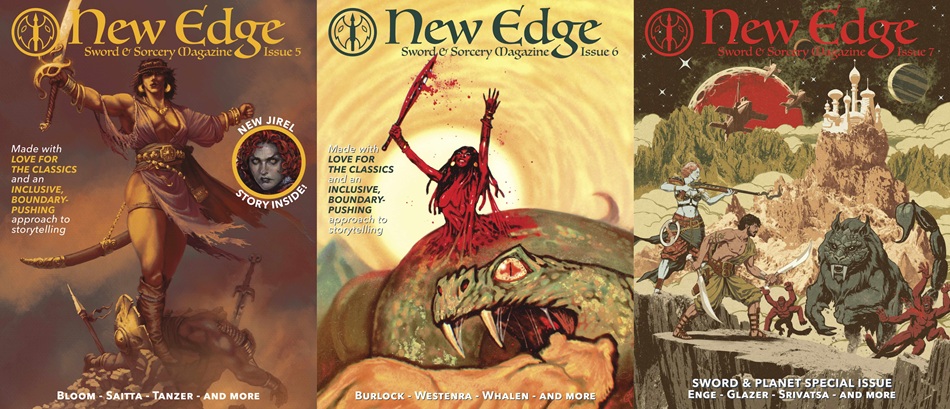 Press Release – NEW EDGE SWORD & SORCERY Backerkit crowdfunding for Issues 5-7:
Press Release – NEW EDGE SWORD & SORCERY Backerkit crowdfunding for Issues 5-7:
Building on their success in 2024, a Backerkit campaign has been launched for new issues.
TORONTO, Ontario, February 13th — Begun in Fall 2022 with issue #0, short story & non-fiction magazine New Edge Sword & Sorcery is running a crowdfunding campaign on Backerkit to produce issues #5, 6, and 7 in accessible digital, classic softcover, and luxurious hardcover (w/endpage art and a bookmark ribbon!) formats. These will be released in November of 2025.
Backing this campaign is a way to be a part of genre history: JIREL OF JOIRY will be returning with her second new story since the originals in Weird Tales! Jirel was the first Sword & Sorcery heroine, created by legendary Weird Tales regular, C.L. Moore. Like Alice in Wonderland with a big f***ing sword, Jirel had compelling adventures in bizarre dream-logic realms, balancing a rich emotional life with terrifying struggles against dark forces! Predating Red Sonja, she & Moore were a direct influence on Robert E. Howard’s writing, as well as so many who came after.
Alas, Moore only wrote a handful of Jirel tales — which are still collected, published, and read to this day. So it’s a good thing that when backers of the campaign helped it hit 100% funding in just four days, they helped make sure a new story will be published! Authorized by the estate of C.L. Moore, “Jirel Meets Death” has been written by the magnificent MOLLY TANZER (editor of Swords v. Cthulhu, author of Creatures of Charm and Hunger, and so much more).
Expanding to three issues a year also allows for the first ever special issue! NESS #7 is dedicated to S&S’ older, science-fantasy cousin Sword & Planet – featuring new S&P tales and non-fiction. Twenty-six other authors are spread across the three new issues this campaign is funding, including names like Alec “Black Beth” Worley, Premee Mohamed, and Dariel R.A. Quiogue.E
very story and non-fiction piece in the issues will be paired with two original B&W illustrations as soon as the crowdfund meets its first stretch goal – Double Art. The goal after that is a fund to cover shipping discounts for backers outside the United States, and from there every stretch goal is a pay raise for contributors. These goals make clear the magazine’s values of paying creators as much as they can, and making NESS financially accessible.
The magazine’s editor, Oliver Brackenbury, promises the magazine is “Made with love for the classics and an inclusive, boundary-pushing approach to storytelling”, delivering high quality writing and art in a wide variety of styles. Sword & Sorcery can be many things and still be Sword & Sorcery…or Sword & Planet!
Readers should race to back the magazine’s new issues before the campaign ends on March 15th, so they can benefit from crowdfund exclusives like bonus stories, discounted back issues, and cover art postcards. They can even win free, unique softcover issues annotated with behind-the-scenes info by chatting about S&S in the crowdfund’s community tab!
With the NESS pastiche continuing the heroine’s saga, here are the Jirel stories- “Black God’s Kiss” (C.L. Moore October 1934)
- “Black God’s Shadow” (C.L. Moore December 1934)
- “Jirel Meets Magic” (C.L. Moore July 1935)
- “The Dark Land” (C.L. Moore January 1936)
- “Quest of the Starstone” (C.L. Moore with Henry Kuttner November 1937)
- “Hellsgarde” (C.L. Moore April 1939)
- “Jirel and the Mirror of Truth” (Molly Tanzer 2024)
- “Jirel Meets Death” (Molly Tanzer 2025)
Ryan Harvey authored two Black Gate posts in 2007, one covering the author’s life and contributions in detail (Jirel ofJoiry: The Mother of Us All) and another reviewing Black God’s Kiss, Planet Stories‘s collection of all of C.L. Moore’s Jirel stories (including a collaboration with husband Henry Kuttner).
The red-haired, yellow-eyed, and lioness-fierce sword-wielding Jirel has an unassailable place in contemporary popular culture, along with her genre cousins, the laser-gun wielding heroine and the wooden-stake-armed heroine. Fantasy, science fiction, and horror no longer have “Males Only” signs over their doors, either for their warriors or writers. So many female authors and protagonists thrive in speculative fiction today that it seems hard to imagine a time when the opposite was the case. It feels impossible to visualize fantasy before Catherine Lucille Moore broke down the gender barriers (even if she did partially disguise her sex behind her first initials, C. L.) and brought with her Jirel. Beautiful, fierce, loyal, defiant, passionate Jirel did more than raise her sword against sorcery. She slashed through the confining walls around speculative fiction and let it reach toward the horizons in a way it never could have before her advent. That achievement alone assures Jirel and her creator a place in the firmament of the stars of fantasy literature.
— Ryan Harvey, Jirel ofJoiry: The Mother of Us All
 Saprophial interior art, NESS #3, Jirel
Author, Artist, and RPG!
Saprophial interior art, NESS #3, Jirel
Author, Artist, and RPG!
If you’re interested in learning more about Molly Tanzer and her approach to writing Jirel, check out the article Old Sorcery, New Edge: Q&A with Molly Tanzer (by Alec Worley, Feb 2024) and the Return of Jirel Interview hosted by Oliver Brackenbury, editor of NESS (2024).
NESS Magazine is always saturated with interior art. Artist Saprophial illustrated four pieces “Jirel and the Mirror of Truth”. The artist was a perfect choice since she also created the art for the 2022 Black God’s Kiss RPG Aventure and Game (check out Blazing Worlds website for more info.)
Back New Edge S&S Issues 5-7 Now! (link)
S.E. Lindberg is a Managing Editor at Black Gate, regularly reviewing books and interviewing authors on the topic of “Beauty & Art in Weird-Fantasy Fiction.” He is also the lead moderator of the Goodreads Sword & Sorcery Group and an intern for Tales from the Magician’s Skull magazine. As for crafting stories, he has contributed eight entries across Perseid Press’s Heroes in Hell and Heroika series, and has an entry in Weirdbook Annual #3: Zombies. He independently publishes novels under the banner Dyscrasia Fiction; short stories of Dyscrasia Fiction have appeared in Whetstone, Swords & Sorcery online magazine, Rogues In the House Podcast’s A Book of Blades Vol I and Vol II, DMR’s Terra Incognita, and the 9th issue of Tales From the Magician’s Skull.
7 Author Shoutouts | Authors We Love To Recommend
Here are 7 Author Shoutouts for this week. Find your favorite author or discover an…
The post 7 Author Shoutouts | Authors We Love To Recommend appeared first on LitStack.
SPFBO Finalist Review: The Forest at The Heart of Her Mage by Hiyodori

ABOUT THE AUTHOR: Hiyodori is not a bird. But she is dearly fond of her namesake, a plain-looking brown-gray bird that likes to perch near her Tokyo apartment and unleash the most incredible primal screams. Hiyodori (the human author) loves stories with fantastical settings and complicated, difficult-to-define relationships. All of her books—including Carrion Saints, her latest standalone novel—take place in the same shared fantasy universe.
The Forest at The Heart of Her Mage links: Amazon, Goodreads
ESMAY
One part dark fantasy quest, one part unconventional f/f romance, one part grief/trauma healing journey, The Forest at the Heart of Her Mage is an exceptionally imaginative and reflective quest adventure that takes the concept of slow-burn storytelling to the next level.
For me, The Forest at the Heart of her Mage started off extremely strong, and it immediately hooked me with its intriguing plot, world and romance set-up. I mean, when you promise me a sapphic opposites-attract marriage of convenience, a quest into a dangerous dark magical forest, and lots and lots of emotional turmoil and trauma… I am IN. And for the most part, Hiyodori totally delivers on all this great potential, albeit not in the way that I was totally expecting or hoping for.
See, on the one hand I found Hiyodori’s wild imagination and refreshingly unconventional storytelling to be extremely impressive and enjoyable. The steampunkish scifantasy world building was so cool to me (even if some aspects felt a bit shallow at times), especially in combination/contrast with the more traditional and almost dark fairytale-esque qualities of the world and story. Particularly the whole concept of mages needing maintenance on their magic cores to prevent them from going berserk stood out to me, not least because I very much like the idea that an operator could maybe swoop in to untangle my mess and fix my physical and mental state up a bit; wouldn’t that be the dream?
Yet on the other hand, I had a really hard time connecting to these characters, and I soon found myself struggling to stay engaged in their quest. There was a certain ‘je ne sais quoi’ missing from Tiller’s narration of this tale for me, and her tendency to lapse into (rather repetitive) introspective reflections of her traumatic past unfortunately hindered the pacing quite a bit for me. And although these characters are quite emotionally complex, I personally felt like they didn’t have personality outside of their trauma and some exaggerated quirks, which made it hard for me to get invested in them.
Moreover, I think marketing this book as a slow-burn sapphic fantasy romance adventure maybe does it a bit of a disservice, since I personally think it shines much more as a nuanced exploration of grief, identity, family, and childhood/generational trauma. Yes, the complicated yet inexplicably fun dynamic between Tiller and Carnelian lies at the heart of this story; and yes, I am always here for romances that rely more on emotional connection rather than physical/sexual attraction. However, I personally didn’t feel any kind of chemistry between them until maybe the last 5% of the book (and even then it was mostly based on guilt and trauma bonding?), and I think that their dynamic shines more as friends than as lovers.
For me, the time spent in the deliciously dark Devouring Forest was easily the strongest part of the novel, closely followed by the long and beautifully satisfying sequence of falling action at the end. So while The Forest at the Heart was maybe a bit of a drawn-out and bumpy ride for me personally, I think Hiyodori ended this unique adventure on a really high note, and it’s more than worth giving a shot if you go in with the right expectations.
ŁUKASZ
Magical forests are nothing new in fantasy, but the one in The Forest at the Heart of Her Mage isn’t a typical enchanted glen with sparkling streams and the occasional talking tree. No, this forest is alive, hostile, and more than a little creepy. Tiller, our protagonist, is voluntarily walking right back into it after two decades of carefully avoiding the place. Brave? Sure. Questionable life choices? Absolutely.
But she’s not going alone. Carnelian, a mage with a bad reputation and a knack for making things complicated, accompanies her. Together, they deal with monsters, mysteries, and politics. There’s also a slow-burn romance with more tension than action.
Let’s start with the good stuff: this is a beautifully layered book. The magical system, split between regimented human magic and the wild, unknowable magic of the forest, is well-thought-out and intriguing. The forest itself feels like a character - alive, unpredictable, and unsettling. And then, the budding relationship between Tiller and Carnelian is as much about peeling back emotional layers as it is about fending off literal monsters, and their dynamic is a highlight. If you like your romance slow-burn with a healthy dose of secrets and snark, this delivers.
But - and there’s always a but - the pacing could be tighter. The story leans into introspection and atmosphere, which is great when it’s working, but occasionally makes the story feel like it’s wading through mud. Tiller and Carnelian spend a lot of time trekking through the wilderness and working through their issues, which is interesting in parts but sluggish in others. The action scenes, while sharp, are scarce, and the overall pace is steady.
Still, the payoff is, I think, worth the time. If you’re in the mood for a book that’s eerie, emotional, and a little meandering, The Forest at the Heart of Her Mage is precisely this.
OFFICIAL SPFBO SCORE

The Spellshop - Book Review
 The Spellshopby Sarah Beth Durst
The Spellshopby Sarah Beth DurstWhat is it about:The Spellshop is Sarah Beth Durst’s romantasy debut–a lush cottagecore tale full of stolen spellbooks, unexpected friendships, sweet jams, and even sweeter love.
Kiela has always had trouble dealing with people. Thankfully, as a librarian at the Great Library of Alyssium, she and her assistant, Caz—a magically sentient spider plant—have spent the last decade sequestered among the empire’s most precious spellbooks, preserving their magic for the city’s elite.
When a revolution begins and the library goes up in flames, she and Caz flee with all the spellbooks they can carry and head to a remote island Kiela never thought she’d see again: her childhood home. Taking refuge there, Kiela discovers, much to her dismay, a nosy—and very handsome—neighbor who can’t take a hint and keeps showing up day after day to make sure she’s fed and to help fix up her new home.
In need of income, Kiela identifies something that even the bakery in town doesn’t have: jam. With the help of an old recipe book her parents left her and a bit of illegal magic, her cottage garden is soon covered in ripe berries.
But magic can do more than make life a little sweeter, so Kiela risks the consequences of using unsanctioned spells and opens the island’s first-ever and much needed secret spellshop.
What did I think of it:When Jeffe told me I should read this book, I was easily convinced as I absolutely love Sarah Beth Durst's The Queen of Blood (I'm so going to get my trotters on the new paperback once it releases, because: have you seen that new cover!).
And this book is so going on my keeper shelves and will be hugged, treasured, and reread!
What a beautiful, touching read. If you need a cozy Fantasy read: look no further and get your hands on The Spellshop!
I loved Kiela from the start, and don't get me started on Caz, because I'll be singing his praises for hours. I mean: an intelligent, talking, sarcastic spider plant!!
The story is so sweet, and I kept reading to see what happens next for Kiela and Caz. There's some danger to keep you on edge, but mainly this book was delightful and full of whimsy. It made me smile while reading.
So you bet I jumped on the chance to read an Advance Reader Copy of the next book set in the same world as The Spellshop.
Why should you read it:It's a beautiful, cozy, and heartwarming Fantasy read.
SPFBO Finalist Interview - Hiyodori, the Author of The Forest at The Heart of Her Mage

ABOUT THE AUTHOR: Hiyodori is not a bird. But she is dearly fond of her namesake, a plain-looking brown-gray bird that likes to perch near her Tokyo apartment and unleash the most incredible primal screams. Hiyodori (the human author) loves stories with fantastical settings and complicated, difficult-to-define relationships. All of her books—including Carrion Saints, her latest standalone novel—take place in the same shared fantasy universe.
The Forest at The Heart of Her Mage links: Amazon, Goodreads
Thank you for agreeing to this interview. Before we start, tell us a little about yourself.
Thanks for having me! I’ve just emerged from a month spent obsessively playing the latest game in the Trails series (epic story-heavy RPGs from a company called Nihon Falcom). I'm still reeling! In a good way, that is.
I’ve been based in Tokyo for a while now, and I love it here, but I pretty much live the opposite of a bustling city life. Some areas are actually very quiet, with plenty of greenery and few high-rise buildings. Each Tokyo neighborhood (usually centered around the nearest train station) feels like a town unto itself. There’s a place for every type of personality.
Do you have a day job? If so, what is it?
Yes—one that uses a totally different part of my brain, so it feels like a refreshing break from writing (and vice versa). Loosely speaking, my role has elements of marketing, business strategy, and project management. So I get to do a lot of planning and light number crunching.
Who are some of your favorite writers, and why is their work important to you?
I really admire Megan Whalen Turner. Every single book in her Queen’s Thief series is a gem of elegant writing, tight plotting, and subtle characterization. She’s unbelievably good at evoking powerful emotions through implication, with understated language. I first encountered her work decades ago, and I love it just as much today. The Queen’s Thief series also happens to contain one of my favorite romantic arcs in any storytelling medium—which, for those familiar with the details, probably tells you a lot about my taste in romance.
I also have a soft spot for Haruki Murakami because (many years ago) his novels were among the first books that I read from start to finish in Japanese.
What do you like most about the act of writing?
Not to turn this question around on you, but there’s really only one aspect of writing that I strongly dislike. Everything else—planning, drafting, line editing, working through story-related roadblocks, and so on—is fun and rewarding in its own time and its own way. I don’t think I could pick a favorite phase of the process.
The one part of it that I find downright grueling comes right after finishing a first draft. This is when I make myself read through the entire manuscript without making any changes. I go pretty quickly, and I take notes about plot issues or things to expand on. I hate this read-through because it kills me to breeze past all my clumsy first draft prose without fixing it right then and there.
Still, I’ve never considered skipping that first read. It’s an invaluable way to get a big-picture view of how the story flows before starting in on line-level edits. Everything else about writing feels like pure joy in comparison!
Can you lead us through your creative process? What works and doesn’t work for you? How long do you need to finish a book?
The Forest at the Heart of Her Mage is around 144,000 words. My final outline for it ended up at almost 48,000 words: a third of the length of the actual book.
Proportionally speaking, my outlines usually end up being just about that long. But I don’t complete the entire thing before I dive into the first draft. I start with an outline of a couple thousand words in length, and then the outline and the novel itself grow side by side, from beginning to end. I keep the outline on my screen at all times when drafting, so I never feel like I’m facing a truly blank page.
All of my novels have been written in Scrivener. Couldn’t live without it.
I write and publish two to three books per year. Counting from the moment I start the first draft, I can have a sub-100k book ready for publication with about four months of near-daily work. But that leaves out all the time I may have spent pre-planning the story (whether in past years, or while wrapping up work on a previous novel).
What made you decide to self-publish The Forest at the Heart of Her Mage as opposed to traditional publishing?
This was my fifth self-published novel. Once I got started with self-publishing, it immediately felt so right that I never considered any other path.
What’s your favorite and least favorite parts of self-publishing?
I love being able to do everything myself. And I really, really love having immediate access to sales data. I suppose my day job gave me a taste for that. I’ve got a ton of respect for traditional publishing, but I would struggle with not being able to see daily orders, royalties, etc. That being said, I don’t do anything terribly sophisticated with all this data. I just happen to find it extremely motivating.
As for my least favorite parts of self-publishing… well, I've completely opted out of social media, for instance. Other than that—self-publishing does offer an astonishing amount of control, but even then, you can't control everything. You’re ultimately still reliant on the fairness and accuracy of publishing platforms, which aren’t one hundred percent perfect for everyone at all times (nothing is).
Why did you enter SPFBO?
I’ve followed the contest with great interest and admiration for several years now. (Another standalone novel of mine—The First and Last Demon—ended up being a semifinalist last year.) It’s an incredibly unique opportunity, especially given the fact that there are no entry fees. I’ve never considered entering any other contests, to be honest.
How would you describe the plot of The Forest at the Heart of Her Mage if you had to do so in just one or two sentences?
Tiller is finally ready to revisit the deadly forest where she grew up. But the charismatic mage who enlists as her bodyguard might end up being more dangerous than any of the forest’s magical monsters.
What was your initial inspiration for The Forest at the Heart of Her Mage? How long have you been working on it? Has it evolved from its original idea?
I wrote and published this novel in 2023. From start to end, it took me about five months total. At the same time, many of the basic story ideas came from an abandoned manuscript that I'd left untouched for almost a decade. Perhaps because of that, I honestly have no memory of what originally inspired me.
While key concepts carried over—the names of the main characters, family relationships, the forest, certain monsters, core emotional dilemmas—what I essentially did was salvage my old novel for parts. I wouldn’t even describe it as rewriting from scratch, because I had no interest in creating an improved version of my unpublished past work. I wanted to cook something brand new with similar ingredients.
What genre does it belong to?
It’s a sapphic fantasy romance. (However, the central romance is very slow-burn and low-heat.)
The story takes place in a fictional world with relatively modern amenities—neither overtly futuristic nor medieval, although the characters spend much of their time trekking around in uninhabited wilderness. In that sense, it could be also described as secondary-world contemporary fantasy.
If you had to describe it in 3 adjectives, which would you choose?
Off the top of my head: eerie, pensive, layered.
Is it part of the series or a standalone? If series, how many books have you planned for it?
This is a standalone novel set in the same overall universe as my other stories (including the Clem & Wist series, which has five books to date). I intended for it to be approachable even with zero prior knowledge of the setting.
Who are the key players in this story? Could you introduce us to The Forest at the Heart of Her Mage’s protagonists/antagonists?
Tiller, the protagonist, is a thirty-year-old refugee from a fearsome magical forest. She’s spent the past two decades living quietly in a major city, helping out fellow refugees while also striving not to attract unwanted attention. At the start of the book, she commits to journeying back to the long-lost village of her childhood.
In romance, the main character’s love interest is often positioned as an antagonistic force—not always in the sense of being an evil villain (although I’m personally all for that), but rather in terms of how they serve to spark conflict and drive the story forward. That’s why I’m labeling the following character an antagonist, despite this not being an enemies-to-lovers story.
Carnelian, the love interest and arguable antagonist, is a military mage with a terrible reputation. She’s a frivolous, charming flirt, better known for drinking and gambling than for following orders. Given the horrific risks posed by the notorious magical forest, she’s also the one and only mage willing to accompany Tiller there as a paid bodyguard.
Personality-wise, they’re total opposites. But both of them have a ton of secrets, which get peeled back little by little as they venture deeper into the monster-ridden wilderness where Tiller first grew up.
Does your book feature a magic/magic system? If yes, can you describe it?
It does! I will attempt to describe it as succinctly as possible.
Some people are born with a metaphysical organ known as a magic core. This appears in the population at random; it’s not hereditary in any predictable way. Each core has a specific number of magic branches (kind of like long trailing veins). In most cases, that number is zero—which means you can’t actually use magic, period, and your core just sort of sits there. Also, each branch needs to be imprinted with a specific magic skill before you can use it. So a one-branch mage would be able to learn and utilize a single type of magic (for instance: a limited variant of short-distance teleportation).
All of the above pertains to human magic, which is heavily regimented. The eldritch magic of the forest is something altogether different. It defies human understanding and all attempts to define it. So this novel features the interaction of those two overarching magic systems: one with strict rules, the other wild and loose.
Have you written the book with a particular audience in mind?
I wrote this book for myself. And—by extension—for anyone who shares my penchant for complex, intense, slow-developing sapphic relationships in a magical world.
That’s what I had in mind when I wrote it, at any rate. Personally speaking, as a reader, the promise of that relationship is what would hook me. On the other hand, I’ve heard from people who’ve enjoyed my novels simply as works of fantasy, even if romance in general isn’t really their thing. It’s an honor to think that my writing might have something to offer other types of readers as well.
What’s new or unique about your book that we don’t see much in speculative fiction these days?
I hesitate to assert that anything in my novel is 100% unique or even rare. I read widely, but the umbrella of speculative fiction covers so, so, so many fascinating stories and concepts. Any one feature I choose to highlight might very well be commonplace in a different niche.
I guess I would instead point to the total package—the way these elements combine together. The main characters are both adult women in their thirties. The setting is contemporary, albeit without a direct parallel in the real world. Magic and technology are seen as complementary forces. The romance becomes emotionally intense over time, but it’s low on sentimentality (and any hints of spicy content are all fade-to-black). There are terrifying monsters and zombie-like beings and violent battle scenes, and there are obvious issues with the society that the characters live in, but the deepest conflicts and the highest stakes are all internal.
Anyway, magical forests are a dime a dozen in fantasy! I hope that the particular details of the one in this story make it feel fresh and intriguing and real (or should I say surreal?).
Cover art is always an important factor in book sales. Can you tell us about the idea behind the cover of The Forest at the Heart of Her Mage and the artist?
I made the cover with an illustration licensed from Shutterstock. The wonderful artist, Tithi Luadthong, can also be found at the below sites.
Instagram: https://www.instagram.com/grandfailure9/
Fine Art America: https://fineartamerica.com/profiles/tithi-luadthong
As for why I chose that specific art piece: I was looking for something with magical forest-y vibes, and it fit perfectly, right down to the mystical figure in the middle. (Which could be interpreted as either good or evil, inviting or menacing.)
What are you currently working on that readers might be interested in learning more about, and when can we expect to see it released?
I’m currently working on a hefty standalone novel (another sapphic fantasy romance) that still needs an enormous amount of editing. It’s quite dark, but also weirdly cozy at times. I’m hoping to have it ready for publication sometime within the first few months of 2025.
Thank you for taking the time to answer all the questions. In closing, do you have any parting thoughts or comments you would like to share with our readers?
It was my pleasure! I’m tremendously honored to be a finalist. I’m a bit reclusive by nature (and that might be an understatement). So I’m continually touched and amazed by how people keep finding and reading my books. I owe a huge thanks to everyone who has ever given my work a chance.
Coming Up For Air | Lewis Buzbee’s “Diver” Elegantly Explores Submerged Emotions
There is powerful storytelling in Lewis Buzbee’s Diver. In the same way you can be…
The post Coming Up For Air | Lewis Buzbee’s “Diver” Elegantly Explores Submerged Emotions appeared first on LitStack.
Teaser Tuesdays - The Naturalist Society
 Beth wondered why showing her journals to Mr. Harold Stanley felt more risqué than stealing a kiss. her heart raced; her hands shook.
Beth wondered why showing her journals to Mr. Harold Stanley felt more risqué than stealing a kiss. her heart raced; her hands shook.(page 3 The Naturalist Society by Carrie Vaughn)
---------
Teaser Tuesdays is a weekly bookish meme, previously hosted by MizB of Should Be Reading. Anyone can play along! Just do the following: - Grab your current read - Open to a random page - Share two (2) “teaser” sentences from somewhere on that page BE CAREFUL NOT TO INCLUDE SPOILERS! (make sure that what you share doesn’t give too much away! You don’t want to ruin the book for others!) - Share the title & author, too, so that other TT participants can add the book to their TBR Lists if they like your teasers!
Wizard Battles and Martial Arts: Legend of the Condor Heroes: The Gallants

Good afterevenmorn!
So, my various social media algorithms were working overtime the past couple of months, bombarding me with clips and training videos for the Chinese movie Legends of the Condor Heroes: The Gallants. And, of course, my interest was more than a little piqued. When I heard that the movie was getting an international release, I got more than a little excited.
Given how much I adore Chinese dramas, and kung fu movies, and the fact that I train kung fu and Chinese kickboxing (called San Da, or less frequently San Shou), there was no way in hell that I would not be going out to see this film.
I went in pretty much blind, with only a trailer (which gave nearly nothing away), and the training videos. So it had virtually no idea what it was all about. This will matter quite a bit, as we will see.
The trailer I saw
What I learnt after the fact is that this film is loosely based on the first (射鵰英雄傳 (The Legend of the Condor Heroes)) of a trilogy of books by Chinese author 金庸 (Jin Yong), which I have not read (but would love to get my hands on a translation of). The novels are technically Wixia, a Chinese historical fantasy, which typically follow an unattached warrior who follows a chivalric code (俠 (xia)). Emphasis on fantasy in this case. More on that later.
Now, I am quite familiar with the male lead Xiao Zhan (肖战), who has been in a number of dramas I’ve watched, but is probably most famous for his role in The Untamed here in the Western Hemisphere. He’s a very talented actor, and I’ve enjoyed most everything I’ve seen him in (and even the ones that were so-so, he was the bright spot for). And I’m so pleased that there was a foreign film that I didn’t have to find a niche theatre for. I was, and am, very happy to encourage more of that.
The last Chinese film I saw in theatres was Crouching Tiger, Hidden Dragon. So… quite a while ago. I remember it absolutely blowing me a way (and wrecking me emotionally), so I was really eager to see this. With that in mind, off I trundled with a couple of my martial arts students on Sunday to watch the movie.
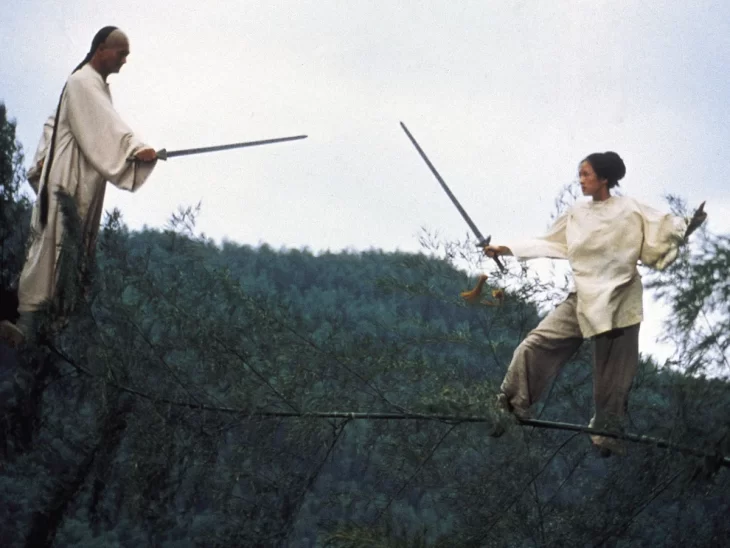 There are three movies I will rewatch any time I need a good cry. This is one of them.
There are three movies I will rewatch any time I need a good cry. This is one of them.
The movie centres on one Guo Jing (郭靖), a Han Chinese man from the Song Dynasty raised in Mongolia by the Khan who took him and his mother in following the strife between the Jin and Song empires (the Jin rise to power shattered the Song Dynasty, and they moved south to become the Southern Song Empire), and the tension between his two identities — a Han Chinese man from the Southern Song Empire and a man raised as a Mongol, by the Khan, and sworn brother to Mongols.
And it was great! A whole lot of fun; but with some caveats.
The first is that, as this was based on a novel, there is a lot of information packed into a relatively short amount of time (just over 2 hours), and if you’re not paying attention, you miss an awful lot. For those of us unfamiliar with the source material, it did lessen the emotional impact of certain scenes. It might be just my 40 episode drama-watching brain, but this probably could have been a couple of movies.
An awful lot is glossed over rather quickly in what feels like a “Previously On” moment. I was left with the feeling that there was a prequel movie that I have not seen. I haven’t done any research on whether that was the case as of the writing of this. When we finally get into the meat of the movie, Guo Jing has separated from the woman he loves, whom he travelled all over the Middle Lands and trained with, and has already mastered the techniques from a much-sought-after scroll, whom this young woman (Huang Rong (黃蓉)) apparently has possession of. Following so far?
 Our heroes Huang Rong and Guo Jing
Our heroes Huang Rong and Guo Jing
Separated, Huang Rong is pursued by three of the five masters — a martial art specialists from three of the five styles of martial arts (kung fu… sort of) in the Middle Lands. The lead, Venom West, desperately wants the scroll she carries. He was, apparently, preciously defeated by Guo Jing in an encounter we only get flashbacks of (rather disappointingly).
I’m not going to give too much away, but eventually the lovers reunite, and simultaneously save both the Khan and the Southern Song Empire; the Khan from Venom West, who has gone mad, and the Southern Song from the Mongols, who were just themselves saved.
The story itself was very fun, with some impressive action sequences, but I find myself a little disappointed that they weren’t more grounded. Remember when I mentioned that the emphasis was on fantasy? Well, all the fighting in this was basically magic battles between wizards. There was actually very little proper fighting involved. Given the training videos I saw, I was expecting a little more proper combat.
One of several videos that promised something that wasn’t delivered.
Crouching Tiger, Hidden Dragon leant into the fantasy, what with the flying through the air and landing on bamboo as if their bones were hollow/they could actually levitate. But the fighting in that was actual fighting; highly choreographed, but fighting all the same. With that as my only reference for Chinese movies, and with the training videos, I do feel a little cheated. Particularly since in several of the training videos, I could recognise the styles employed.
There was no real hand-to-hand combat in the film.
Now, it’s entirely possible that the training shorts I saw were actually for a completely different project. I do know that many of these actors are incredibly busy, working or three or more projects a year. So it’s entirely possible that all the videos were mislabelled and were for something else entirely.
The movie also ends in what feels like the middle of the story. Hardly surprising since it’s the first book in a trilogy. The sort-of middle-of-the-story vignette that this film presents is not unlike My Neighbour Totoro. Both movies left me with an “this is unfinished” feeling.
 The Khan’s daughter and a love rival. I loved her character a lot.
The Khan’s daughter and a love rival. I loved her character a lot.
Despite the slight disappointment of all the fights being wizard battles, and the unusual feeling of being shown but a snippet of a story, however, the movie was a whole lot of fun. I loved hearing both Mandarin and Mongolian. I loved how the Mongols weren’t made the villains (I initially thought they were, and it would have been easy to have made them thus — kind of like Russians for 80s Hollywood movies). And I adored having something other than the increasingly formulaic and mindless films we’ve been fed of late to spend a Sunday afternoon watching.
I really do wish more foreign films would get wide releases like this. We could use the fresh perspectives and fascinating stories other cultures bring. I had a lot of fun with this one. If you are going to see it, you must pay close attention, but it was certainly worth it. If there are sequels that make it out our way, I’ll definitely be watching. But first, I need to get my hands on English versions of these books!
When S.M. Carrière isn’t brutally killing your favorite characters, she spends her time teaching martial arts, live streaming video games, and cuddling her cat. In other words, she spends her time teaching others to kill, streaming her digital kills, and a cuddling furry murderer. Her most recent titles include Daughters of Britain, Skylark and Human. Her serial The New Haven Incident is free and goes up every Friday on her blog.
Monday Musings: A Little Piece of Italy
Last April, after a grief-filled winter, and a previous fall that was more difficult than I could possibly describe, Nancy and I went to Italy for three weeks — a long-delayed trip that had once been intended as a celebration of our 60th birthdays, both of which were more than a year passed by then.
While in Italy, we spent four lovely days in the ridiculously picturesque city of Venice, and while there, we took a day to visit Murano, a portion of the city that is renowned for its glass factories. It is, if you are not familiar with the history of glass-making in Venice, home to the Murano Glassworks, one of the most renowned glass producers in the world. It is also a gorgeous part of the city. We had a great time there, walking around, looking in shops, getting some food, enjoying the play of color and light on the waterways and old buildings. We watched a glass-blowing exhibition at the Murano factory, and bought many gifts for friends and family back home, as well as for Nancy.
While walking around, searching for a small souvenir of my own, I stopped in at a modest shop on a square, and found, among other things, several small squares of glass in which were embedded finely-wrought images of bare trees. I was captivated and started up a halting conversation with the shop’s owner, who spoke only a bit more English than I did Italian. We managed to communicate, though, and had a very nice exchange. The works in question, it turned out, had been done by the man’s father. He shaped the trees out of strands of steel wool and then placed them in small molds which he filled with melted glass. Each image came out slightly differently. All of them were delicate and beautiful and utterly unlike anything else I had seen in Venice (or anywhere else, for that matter).
I bought the one you see in the photo here. It is small — only 2 1/2 inches by 2 inches — and it is signed — etched, actually — by the artist. I don’t recall what I paid for it. Honestly, I don’t care. I love it. The man wrapped it up in tissue paper, took my payment, and I left his shop, likely never to see him again.
 I kept it wrapped up even after we returned to the States. My plan was to open it once we were in our new house, which is what I did. It now sits in my office window, catching the late afternoon sun. And it reminds me of so much. That trip to Italy, which marked the beginning of my personal recovery from the trauma of losing Alex. That day in Venice, which was gloriously fun. The conversation with the kind shopkeeper, whose love for and pride in his father was palpable throughout our exchange. More, that little glass piece is an image of winter, and it sparkles like a gem when the sun hits it. It reminds me that even after a long cold winter, a time of grief and pain, there is always new life and the joy of a new spring.
I kept it wrapped up even after we returned to the States. My plan was to open it once we were in our new house, which is what I did. It now sits in my office window, catching the late afternoon sun. And it reminds me of so much. That trip to Italy, which marked the beginning of my personal recovery from the trauma of losing Alex. That day in Venice, which was gloriously fun. The conversation with the kind shopkeeper, whose love for and pride in his father was palpable throughout our exchange. More, that little glass piece is an image of winter, and it sparkles like a gem when the sun hits it. It reminds me that even after a long cold winter, a time of grief and pain, there is always new life and the joy of a new spring.
 A cliché, to be sure. But as with so many clichés, it’s rooted in truth.
A cliché, to be sure. But as with so many clichés, it’s rooted in truth.
That little tree — the simplicity of steel wool preserved in glass — brings me joy and comfort all out of proportion to its size and cost. I think Alex would love it, too.
When we were getting ready to move, Nancy and I unloaded a lot of stuff. We talked often of the joy we derived from “lightening our lives,” culling from our belongings items we no longer needed or wanted. And I am so glad to have done that work. But I will admit that I still get great pleasure out of many of things we kept, including little tchotchkes (Yiddish for “trinkets” or “little nothings”) like this one.
Wishing you a wonderful week.
Spotlight on “The Unwanted” by Boris Fishman
The Unwanted is a stunning story of what the most powerless among us will do…
The post Spotlight on “The Unwanted” by Boris Fishman appeared first on LitStack.

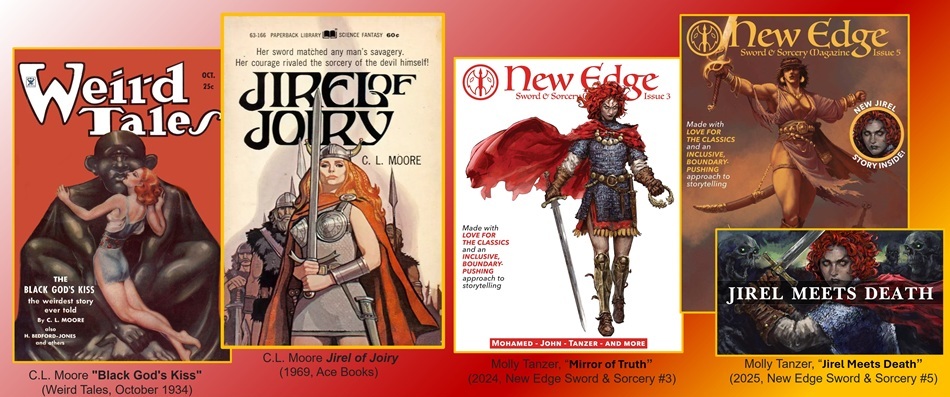
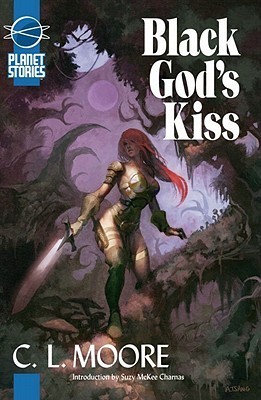


Recent comments